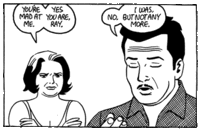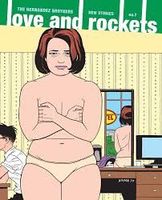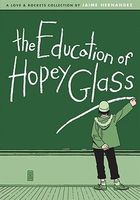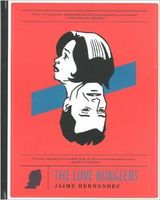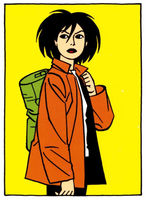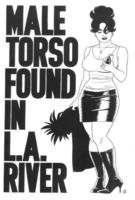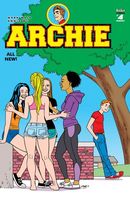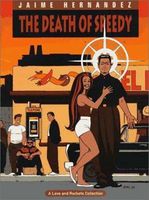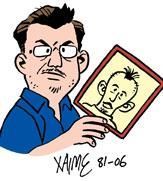Go Ahead Punk, Make My Art
By Koom Kankesan
Jaime Hernandez's characters are to Archie's Betty and Veronica what Anna Karenina is to Snow White. That is, they're both beautiful but one of them has a helluva lot more going on. More so than any of the people I've interviewed regarding comics, Jaime's writing and art are inseparable. There is a deep pool of intelligence and insight flowing into those little drawings. Their characters convey unspoken monologues with just a little downturn of the mouth, the articulation of an elbow, a drift of the eyes. Most comic readers hold the truth to be self evident: you cannot separate writing from art in a good comic. This is especially the case with Jaime's work. Possessed of a sense for line, design, and composition that are immaculate as they are sharp, the work seems to be composed of tensile vibrating wires.
With his brother Gilbert Hernandez, Jaime has been putting out Love and Rockets in one form or another since the early eighties. Initially a fusion of punk rock and sci-fi roots, it quickly grew into an urban literary phenomenon. Characters aged in real time. Stories sprawled, crossed over, and rippled: the tapestry became very, very rich. The instantly-iconic elements of Jaime's art - his women - have changed hairstyles, gained weight, moved, entered and exited life-changing relationships, gained perspective, and accumulated the ruddy calves and puffy eyes of everyday life. Yet they are as beautiful as ever, perhaps even moreso. This combination of beauty and deftly articulated reality lends Jaime's work its unique and enduring brilliance.
When I talked to him on the phone, his responses were quiet and unhurried. There was something deliberate and understated about his manner. Not the maelstrom of punk music, but an embodiment of the saying still waters run deep. Much like his art.
I dare you, I double dare you, not to fall in love with it.
Koom: My first question is about Maggie and Hopey, the centre of your work. In Love and Rockets, volume three, you have that wonderful story with Ray and Maggie where we see them backwards and forwards in time. Their lives are mirrored and it seems like it's kind of a wrapping up. The water swirls out of the drain in a very satisfying beautiful way (in terms of story) but the last couple of issues have featured Maggie and Hopey. Once again, you look at their relationship and their friendship and their strange contours and anxieties. Do you feel that you're going to be working on Maggie and Hopey pretty much your entire life, your entire career?
Jaime: I'll do Maggie and Hopey as long as I have ideas for them (chuckles). I won't always do them. Obviously, I take breaks. I've got no reason not to do them. I like writing Maggie more than I like writing Hopey right now.
Your CanLit News
Subscribe to Open Book’s newsletter to get local book events, literary content, writing tips, and more in your inbox
Koom: What about Maggie and Ray?
Jaime: I like writing them too. Maggie is such a powerful force for me that she hogs all the stories. I know her so well because her emotion, her personality, everything about her, just takes over for me. By the time the story's finally finished, I'm like: I'm going to give Maggie a break, because I just want to concentrate on other things. And then I bring her back in and she just does the same thing. She soaks up the air in the room, you know?
Koom: Yeah. As a reader - I definitely find she is extremely relatable. When you bring her back, time has moved on and there's this new version of her that's just as compelling as anything from before. Sometimes when I read your other stuff like a Tonta story, or Angel of Tarzana is a good example (she seems like a sort of prototypical Maggie), they don't have the same weight and roundedness and contours that Maggie does. I totally see that as a reader. You were about to talk about Hopey, saying that you don't enjoy writing Hopey as much? I noticed that with Maggie, you get a lot of interior monologues whereas with Hopey, you never do, really. Maybe the story that most sticks out (in terms of Hopey's interior) is the one where she's a teacher's assistant, The Education of Hopey Glass, and that's a very sympathetic portrayal of Hopey but you're still looking at Hopey from the outside, and she's a very cutting, fleeting... you know, she's got a bit of a demon in her. Which is great, because Hopey and Maggie are contrasts but where do these characters come from? Are they based on people you have known, people you have grown up with, where do you look in terms of defining them now in your career, twenty, twenty-five years on?
Jaime: Now they've taken a life of their own. I rarely think outside of them. You know, I just know them so well. When I said I didn't enjoy writing Hopey, it's just that at the moment, she's a struggle. It's a struggle to write her because I don't know her as well anymore. She's kind of a person that I'm not that close to. If she existed in real life, she would come in and out of my life but I don't really know what makes her tick. So it's always interesting but sometimes it's a struggle to figure out where she belongs and that was on purpose so it's... you know... Maggie just spills out of me. It's not always fun because I'm not sure I make the right decision with her (Hopey) in the direction she goes and at the same time, I don't want her to be like Maggie - easy to write - but at the same time, I wish she was (chuckles).
Koom: That's what makes such an effective contrast. I mean, I don't think you've made a single wrong step with any of your stuff with Maggie and Hopey and I'm not just saying that. I think that stuff is endlessly fascinating, especially the whole... you know, how Hopey deals with her relationship with Maggie, knowing that she can't completely have her: she has to make allowances. I was just re-reading that story last night with Tony Chase where Mary Christmas says that in a rare moment of vulnerability, Hopey admitted that the only way she was going to have Maggie was if she made allowances, to the point where she's okay with Maggie marrying someone else (a guy). At the same time, there's this warm, actual connection between them. I should get to a question: you were saying at this point that you just work with the characters as they are. They're not based on other people. In terms of the drawing or posing, do you get models in? You're known for very realistic (figurative poses and gestures) drawing. I know it's taken on a very cartoony lexicon in recent times though. You have very realistic scenes with them, extremely realistic moments in the writing. What are your influences or inspirations? Where do you get that from?
Jaime: Gee, from everything.
Koom: Are you sketching constantly?
Jaime: No, not really. I'm just observing the way people are. I'm not out studying people. I listen and I watch a person talk many times and I just notice where they're coming from or where they're not coming from. I've just been observant that way since I was very young and I kinda know what makes people do the things they do once in a while.
Koom: Is this mostly a close circle of people you know that you observe or are you the kind of person that just goes out and sits in a mall, just goes to a street carnival and observes people?
Jaime: I don't purposely go out and do that but if I'm in a situation where I do go out - for example, I'll take my daughter to the mall or something because I never go - I'll sit there and I'll watch the different kinds of people and where they stand in society and just notice how the have's and have not's relate to shopping differently. Just simple things like that. I've always been curious about that and when I found out I was good at putting those things down on paper, I kind of took advantage of it because you know, whether I have certain limits in my work, certain artistic limits, I concentrate on what I'm best at.
Koom: One of the things you're good at is your writing style, the edginess of it, also the stylistic unconventionality of the writing. Does this at all come out of a punk sensibility (doing things in a new, energetic, disruptive way) or do you see the punk element in your work as content only - Maggie and Hopey's past, etc. Do you see writing as very different from the punk forces in your youth or is it part of the same continuum?
Jaime: The storytelling comes from me. Punk was the thing that gave me courage to do it my own way.
Koom: Over the years, you've developed quite a sprawl of stories, mapping characters through time and also branching out to other characters that they know, minor characters. Do you plan stuff out, do you map stuff out, or do you just literally go with whatever you feel like in terms of direction and storyline/arc at the time?
Jaime: Both. Mostly, I'm just doing it as I'm going along. Where the characters are going, I'm following. Maybe something, an interesting side story will come out of that. But I don't have big long range plans, except that I hope I can do this as long as I can.
Koom: But you do a little mapping and you try to keep abreast of other characters and where they're going so that you're not...
Jaime: Uh... sometimes... but not too much
Koom: Okay, you were talking about Hopey a moment ago and your choices as to who to write about - maybe it's because she comes in momentarily that her appearances seem so effective? It's always a zinger. When she has something to say, it's pregnant with a lot of emotion but also an edge, a sharp dig, makes fun of the other person so she's not going to be hurt by them. How do you go about constructing these moments? When you say you have certain strengths or certain techniques, it's not a linear way of writing. It's not a linear way of constructing comics. I don't just mean you jump around in time. I mean: how do you pick those moments?
Jaime: It's going to sound simple. It's not. I've taken my whole life to get this. But basically, I'm thinking the whole time - okay, these characters I'm using: who are they? And how would they end up? How would they deal with a situation? Basically, Hopey is a reactor. She has no thought balloons anymore. In the early days, she did but I decided to take out her thoughts because you're not supposed to know what she's thinking. Hopey is just someone who's going to come out with something and you don't know what it's going to be. But I try to remain in it being Hopey. I don't say 'she's going to say something off the wall. I don't care what it is. We'll see what happens.' I really think about who she is when she's saying this and what the reasons are. Sometimes they're not nice things because of where she comes from. And it's very... Hopey. Whenever these moments come, whomever I'm dealing with, I kind of let it happen. Of course, I'm overseeing it, but I go: 'this is the type of people they are and I'm forcing them to be themselves.' It's not always going to be nice and it's not always going to work. People are going to butt heads and you know, yeah... but I'm just kind of an observer myself.
Koom: When I was young and read the first volume of Love and Rockets, I often wondered whether your brother Gilbert's character Carmen and your character Hopey were based on the same person? I have to ask this question because I've always wondered.
Jaime: I don't know...
Koom: Don't you think - you know, in the way they kind of bristle...
Jaime: Yeah, yeah, of course. Of course. But I don't know what Gilbert was thinking.
Koom: You never talked about all that stuff back then? I figured you would have.
Jaime: Sometimes we do but we like to leave each other alone, mostly. Kind of like: Gilbert's a big boy - he knows what he's doing (chuckles).
Koom: He's technically bigger than you, I think...
Jaime: Yeah... we talk about that kind of stuff and every once in a while, we can go 'oh!... huh!' because nobody's really trying to copy each other, or trying to compare to each other, you know?
Koom: There are a couple of questions I can ask in relation to that. One is - what's the next phase? Are you going to continue putting out stuff together or just do your own thing or...?
Jaime: It depends. I don't know. I'm just trying to get Love & Rockets to come out regularly as a comic.
Koom: So you're currently doing a new volume of the comic together and it's still called Love and Rockets?
Jaime: Yes, and it's back to the magazine size like the original volume.
Koom: So, it's just a change in size? It's not a change in the dynamics of what you're doing?
Jaime: No, as a matter of fact, when we came to this decision, I was trapped in three continuing stories. So the first issue doesn't start fresh. It just continues from the last volume.
Koom: Got it. I've always wondered - if I had to work with a relative, let alone a sibling, on something that long and that meaningful to my life, I think maybe it would be a challenge... well, you know very well what it's like to be in a band, for example, with a sibling - not yours necessarily, but anybody's - is it tough or is there competition at all? Is there ego bruising or is it the most easiest thing in the world?
Jaime: Hmm... I've always just handled it as: me and my brother are doing a comic side by side. We don't collaborate so that cuts down on a lot of tension and clashing. I trust Gilbert as a fantastic artist that I'm always proud to be next to. It's not like I'm ashamed of what he did in some issue or something.
Koom: No... never, never...
Jaime: And a big part of that is Gilbert's a big boy. I know Gilbert knows what he wants to do, and as long as I don't have to drag him along, then there doesn't have to be a clash.
Koom: Cool. Both of you are known for your female characters. Once again, apologies if this has been asked to you a thousand different times in a thousand different ways but what is it about women characters that draws you? Why are you so astute with women characters? Do you have a theory as to what makes women characters strong attractors on the page, or makes them tick?
Jaime: God, there's a million answers for that. The main one is 'I don't know, but I just love women.' I like women and I like drawing women and it's the right thing to do. And... I've been told I just have an insight, that I understand. It's a million things, you know. I get my cake and I eat it too.
Koom: How about drawing them? Your body language and the little touches in terms of depicting physique are incredible. At this point, do you ever look at references or... I already asked you if you use models, and I don't think you do. I have a feeling you don't. I think you employ a very studied cartoon lexicography that you've developed and built on. I guess going back, you've built on Hank Ketcham and John Romita and Jack Kirby and people like that - Dan DeCarlo. But at this point in your career, how do you get those little things that just snap together and work so well?
Jaime: I guess the main thing is... whatever they're talking about, the drawing has to help. And a lot of the writing is in their action, is in their expression, is in just the way their posture... I went through a big time where people weren't even looking at each other - I'm trying not to anymore - because they had to look at the reader for you to get the message as to what they're thinking. And I felt guilty about that because they're not even looking at each other (chuckles) when they're talking.
Koom: I don't mind that so much because it makes you feel like you're at the bar with them, listening to them talking.
Jaime: I try to put in as much realism even if it's just lines on paper. I try to put in as much as I can but sometimes you have to sacrifice it for tricks. Like facing the character forward so the reader knows what's going on. It can be frustrating to go see your favourite band and the whole time, the guitar player's staring at his speaker. It's just a juggling act. A constant juggling act. Every panel has multiple things going on in it. Like one person is angry and another person is trying to avoid that. It's a constant juggling act of how to place the characters and how to make them look good on the page. And to do a good drawing and how to get a point across. I'm just so used to that now but I can see how that would drive someone else crazy.
Koom: I think your earlier stuff was very realistic, very rounded, a lot of shading and depth and cross hatching... the detail of course... but now I feel like you've gone for cartoony aesthetics which is really interesting, because it works very well with the timing of your panels. Like you say, a character will say something and then you have to notice the reaction on the other person's face or the way their body reacts, because it's all very precise and styled. That's how you follow, gain insight into the story. Also, that combination between the fairly adult, edgy tone of what they're saying plus the cartoony-ness of the way they're drawn works really well. I don't know if that's your intention but for me, it's working really well most of the time.
Jaime: Yeah, I'll use - I was talking about tricks - I'll use things to make that point come across a hundred percent. If I want it vague where I kind of leave the reader a little in the dark or I allow the reader to make up their own mind, that's a different story but I've finally come to a point where the art is exactly what it is and I didn't even notice that it went from one point to another. Getting rid of the cross hatching and stuff - I just found the most important lines that needed to be put down. When I think of somebody else drawing this and then saying 'I'm going to add my touch to it,' I go: what's there to add?, because it's all there. It's come to become something very simple with lines and expression - you know - all it needs. When someone else asks me to draw - I've done a couple of Archie covers -
Koom: Sure - they're beautiful.
Jaime: I was like, well, I want to put my slant on it but at the same time, these characters are so iconic to me, yet the styles have changed so much over the years. I don't know what I could add so I draw what I draw. You know, I just put the lines down that I do.
Koom: But then it looks like a Jaime Hernandez page. It looks like women hanging out. One woman I remember in particular wears this, almost, a track suit kinda thing. And the hair and the body posture - it's like Archie through Jaime Hernandez's world, you know?
Jaime: Yeah. It may sound silly to some people but that's the way I draw. You know, I can't see what else I could put into it that would help. And hopefully, there's something else in there that I didn't notice that I added that was my own touch. Somebody would see a drawing of mine and say 'you did this with so many lines - you're saying something here' and I'm just like 'sure, sure,' but then I have to go look and it and go: 'what did I do?'
Koom: In some of the earlier stuff, especially The Death of Speedy, the Mexican American identity was more forefront, but that hasn't been the case in the stories that have come up recently. I was just wondering - with Trump coming in and all of the crap about the wall - has that made you want to tackle those issues again, in any new way?
Jaime: I think of that stuff once in a while, but it's just whatever comes - you know? When you think about it, this comic is still about Latinos. People get so close to Maggie, they forget that this is a Mexican girl they might not talk to on the street.
Koom: A lot of your media exposure I saw growing up either portrayed you as a Latino cartoonist or more often, as a sort of gender theory based cartoonist. I always related to your characters as a writer and lover of comics because they just feel real to me. They're real and they're beautiful in a way that a lot of comics can't quite get, you know?
Jaime: Right.
Koom: With other comics' characters, sometimes, I feel like the strings are being pulled. When you see stories about Maggie and her siblings as children, the ethnic identity's right there. It's not always stated but it's there. When her brother comes back into her life and what a horrible life or experience he's having - how unhappy - you can't divorce that from their ethnic identities, I don't think.
Jaime: Yeah. But it's up to the reader, you know? Am I doing a Latino comic or do I just do Latino stories once in a while? Well, they're about Latinos. So I am doing a Latino comic. But like I said, I let the reader make up their own mind. The way they want to see it.
The views expressed in the Writer-in-Residence blogs are those held by the authors and do not necessarily reflect the views of Open Book.
Koom Kankesan was born in Sri Lanka. While his family lived abroad, the civil war in Sri Lanka broke out and this caused them to seek a new home. They eventually settled in Canada and have lived here since the late eighties. He has a background in English Literature and Film Studies. Koom contributed arts journalism to various publications before becoming a high school teacher in the Toronto District School Board. Since working as a teacher, he has taken semesters off now and again to work on his fiction. The Tamil Dream, his new book, is his most ambitious to date. It looks at the end of the civil war in Sri Lanka and how it affected Tamils here in Canada. Besides literature and film, Koom has deep interests in history and science, and an enduring love for comic books.
You can write to Koom throughout January at writer@open-book.ca.
